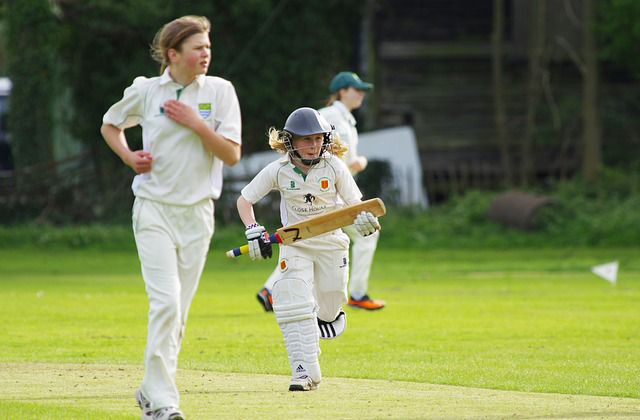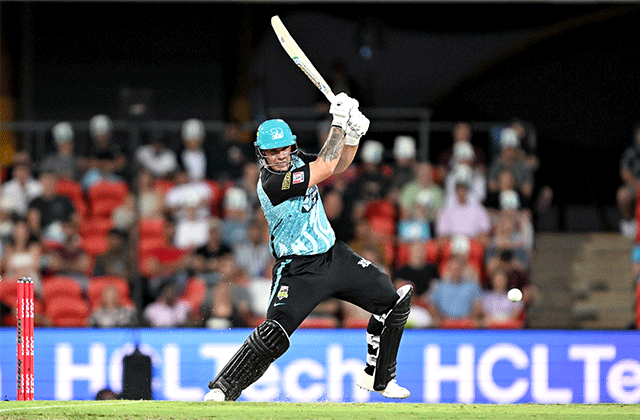
Cricket is a popular sport that originated in England and has gained widespread recognition across the globe. It is not just a sport; it’s a passion that fosters teamwork and sportsmanship among players and fans worldwide.
Team composition in a cricket match
A team consists of:
- Batters (specialized in batting but can bowl)
- All-rounders (specialized in both batting and bowling)
- A Wicket-keeper (usually a batter, very rarely bowls)
- Bowlers (specialized in bowling)
Here's an overview of how cricket is played step by step:
Cricket is the game played with bat and ball between two teams, each comprising of 11 players, where one team bats and the other team bowls and fields. The first team or batting team sets the target first by scoring as many runs as possible and the second team or bowling/fielding team will bat second to beat that target to win the game. If they can beat the target then they win the game, if they can’t then the first team wins the game.
It is played in a mostly round shaped ground and the main batting and bowling takes place on the central area called as pitch which is roughly about 22.5 meters by 3.05 meters of hard clay surface.
In the ground, a big circle is marked with the paint or the rope or the advertising materials to indicate the playing area, this line is called the Boundary line.
Three stumps are placed upright and topped by two bails, forming the wicket on each sides of the pitch.
A cricket match has 2 innings(ODI and T20) and 4 innings(Test match). In one innings, a team gets a chance to bat and while the other team fields. An innings consists of overs. A over consists of 6 deliveries/balls that a bowler bowls from one end of the pitch.
1. Coin toss is the first thing that happens before the game to determine which team will bat or field first. Both the team captains will contest the toss and the winning captain will decide what his team will do.
2. Then the batting team will send 2 opening batters to bat. Any of those 2 batters can face the first delivery/ball. The section on the pitch where they bat and has to stay within then the ball is in play, is called crease. The batting team can bat for the allocated numbers of overs or until their 10th wickets falls or declares(in test cricket).
- The bowling/fielding team will have 11 players on the field, one will be bowler, one will be wicket-keepers and the remaining nine players will be fielding in various positions.
3. The goal of the batting team will be to set the higher target by making as many runs as possible and hitting Fours or Sixes, protecting their wickets or losing as less wickets as possible.
- When the batter is ready to face the ball/delivery, then the bowler will bowl a ball.
The batter will try to defend the wicket/stumps or hit the ball where there are no fielders and run or reach to the other side of the crease across the line on the ground before the fielders can collect the ball and disturb the stump bails. - Run: One run is scored when the batters successfully run between the wickets. Now the other batter will face the ball. If they take two runs then the same batters will face the ball.
- Four: Four runs awarded if the ball crosses the boundary touching the ground at least once
- Six: Six runs awarded if the ball goes over the boundary without touching the ground.
- Any individual runs scored by the batters will accumulate also towards the team’s total.
- When a batter gets dismissed then the other batter will come to the crease.
4. While the goal of the bowling/fielding team will be to take as many wickets(up to 10) they can, while giving awat as less as runs as possible.
- The bowler tries to take the wicket in other words dismiss the batter while trying to restrict the scoring.
- After the over is finished or 6 legal deliveries/balls are bowled then another bowler will bowl from the other end. Also batter who faced the last ball of the previous over will not face the first ball of the next over.
- Wicket: Batters are dismissed if the bowler hits the stumps and dislodges the bails, or if the fielding team catches the ball hit by the batter before it touches the ground, among other methods(explained below).
- The bowler will also try no to give away the extra runs by trying avoid wide balls and no-balls.
- Fielders are strategically positioned to stop runs, catch the ball, and throw it back to the stumps to prevent batters from scoring runs.
5. After completing their innings or a set number of overs or if the 10th batter is dismissed, teams switch roles. The team that batted first now fields, and vice versa.
6. Winning the Game: The team that scores more runs in the allotted overs or innings wins the match.
What are the basic rules of Cricket?
While the basic rules of the Cricket is same for all the formats but there may be slight variations in the numbers of overs that can be bowled in one innings between Test cricket, Twenty 20 and One Day cricket.
* The Hundreds is the new format started in England and it has 100 balls per innings.
OVERS:
- An over can only consists of 6 legal balls/deliveries bowled by a single bowler from one end of the pitch.
- Then different bowler will have to bowl the next over from opposite end.
- At the end of each overs, the batter who faced the last ball of the previous over will not face the first ball of the next over.
BATTERS:
- A batter can only bat once in one innings until he gets out.
- At any given time there can be only two batters batting from the batting team and only one batter will be facing the bowler.
- A batter has to hit or try to hit the ball only with bat not with any body parts intentionally.
- Runs are scored when the batters successfully run between the wickets after hitting the ball.
- When a batter hits the ball with bat and it reaches or goes to the boundary line after bouncing on the ground at least once, then it’s called a Four and 4 runs are added to the batter and also to the batting team.
- When a batter hits the ball and it crosses the boundary line(or hits the line) without bouncing on the ground at all, then it’s called a Six and 6 runs are added to the batter and also to the batting team.
- Leg-bye: When a batter tries to hit the ball with bat but he/she misses it and the ball is deflected off the batter’s leg-pads or any body parts/gears and goes where there are no fielders then the batter can take the run/s; if they take runs/ successfully, it is called leg-bye/s. The number of runs the batters ran will be awarded to the him/her and the team.
- Bye: Similarly when a batter tries to hit the ball with bat but he misses it completely and the wicket-keeper also fails to collect the ball. Then the batters can take the run/s before the fielders gather the ball, if they take the run/s successfully, it is called bye/s. The number of runs the batters ran will be awarded to the him/her and the team.
- A bowler has to bowl the ball within batters reach and within the pre-determined line drawn on the either side of the stumps but on the same side as per batter’s batting stance whether he/she is left-handed or right-handed.
- A bowler can bowl the ball bouncing once or without bouncing on the pitch however he/she can not deliberately bounce the ball more than once on the pitch or roll the ball.
- Full-toss: If the batters hits the ball with bat before the ball bounces on the pitch then such delivery is called full-toss.
- No-ball: A bowler has to bowl a ball from behind a bowling line on the crease. If the feet crosses that line or no part of the feet is behind the line then it’s called No-ball.
Also when a bowler ball the full-toss which is higher than a batter’s waist, then it will be called No-ball - A batting team is awarded 1 extra run for the No-ball.
- Wide: When a bowler bowls the ball beyond the the pre-determined line drawn on the either side of the stumps or out of batter’s reach then it will be called Wide.
- Similarly if a bowler bowls the ball which bounces higher than a batter’s reach, then it will be wide.
- A batting team is awarded 1 extra run for the Wide.
- In T20, One Day and Test cricket same bowler can not bowl consecutive overs from the same end.
- A batter is dismissed or out, when the batter hits the ball with the bat or sometimes when the ball is deflected off the batter’s glove after the bowler bowls a ball and any fielders catches the ball before it touches the ground.
- A batter is also dismissed if the bowler hits the stumps and dislodges the bails with the ball while bowling or the balls hit the batter’s leg-pads which would have otherwise gone on to hit the stumps.
- A batter is also dismissed, while he/she is attempting to take a run and any fielders dislodge the bails before the batters reaches the opposite.
WICKET-KEEPER:
- There will be a dedicated fielder who will field behind the stumps/wicket and except for the wicket-keeper, no other players are allowed to wear gloves for fielding.
What are the formats of cricket?
Cricket is played in several formats, each with its unique rules, durations, and characteristics. Here are the main formats of cricket:
1. Test Cricket:
Test cricket is considered the most traditional and purest form of cricket. Matches are played over five days, with each team batting and bowling twice. There are no limitations on overs per team innings. It is known for its strategic depth and endurance, testing players’ skills over a more extended period.
2. One Day International (ODI):
ODI is limited-overs format with each team facing a fixed number of overs, traditionally 50 overs per side. It is usually completed in a single day, hence the name “One Day International.” It’s suited for a more aggressive style of play, balancing both batting and bowling strategies within limited overs.
3. Twenty20 (T20):
T20 is the most fast-paced and shortest format of cricket. Each team bats for a maximum of 20 overs.
It is typically completed in about 3 to 3.5 hours, promoting aggressive and entertaining gameplay.
Known for its explosive batting, strategic field placements, and innovations in the game.
These formats cater to different styles of play and have their unique fan bases. Test cricket emphasizes endurance and strategy, ODIs balance skill and pace, while T20s focus on quick, entertaining gameplay.
Additionally, variations like T10 cricket, played with even shorter overs (10 overs per side), and exhibition matches like The Hundred (100-ball format) have also gained popularity in recent times, aiming to further condense the game for faster entertainment.
Each format demands different skill sets from players, making cricket a versatile sport appreciated by diverse audiences worldwide.
How many ways a batter can be dismissed?
In cricket, a batter can be dismissed in various ways. Here are the main modes of dismissal:
- Bowled: The bowler delivers the ball, and it hits the stumps, dislodging the bails. If the batter fails to defend the wicket with the bat and the ball hits the stumps, they are out.
- Caught: When the batter hits the ball, and it’s caught by a fielder (without bouncing) before it touches the ground, the batter is out.
- LBW (Leg Before Wicket): If the ball would have hit the stumps but instead hits the batter’s leg before hitting the bat, and the umpire judges that the ball would have gone on to hit the stumps, the batter can be given out.
- Run Out: If a fielder dislodges the stumps with the ball while the batter is running between the wickets and the batter fails to reach the crease before the stumps are broken, the batter is out.
- Stumped: When the wicketkeeper (or fielder) removes the bails while the batter is outside the crease and not attempting a run, after the batter has missed the ball, the batter is out.
- Hit Wicket: If a batter dislodges the stumps with their bat or any part of their body (accidentally) while trying to play a shot or take a run, they are out.
- Handled/ling the Ball: If a batter deliberately touches the ball with a hand not holding the bat, without the consent of the fielding side, they can be given out.
- Obstructing the Field: If a batter obstructs a fielder’s attempt to field the ball by any means, they can be dismissed.
- Timed Out: If a new batter takes longer than a specified time to come to the crease after the previous wicket fell, they can be given out.
- Double hit/hitting the ball twice: If a batter hits the ball two times.
These methods of dismissal ensure a balance between bat and ball, making cricket an intriguing sport where both batting skills and bowling/fielding prowess are equally significant.
What equipment are required to play cricket?
Cricket requires several pieces of equipment to play safely and effectively. Here’s a list of the essential gear:
Bat: Used to hit the ball. Cricket bats come in various sizes and materials.
Ball: A hard leather ball, typically red for test matches and white for limited-overs formats like One Day Internationals (ODIs) and T20 matches.
Stumps and Bails: Three stumps placed upright and topped by two bails, forming the wicket.
Pads: Worn by batsmen to protect legs from the ball. They cover the shin, knee, and sometimes the thigh.
Gloves: Batsmen wear gloves for hand protection while batting. They vary in style and padding.
Helmet: Essential for batsmen and wicketkeepers to protect the head from fast-moving balls.
Protective Gear: This includes abdominal guards (box or cup) for male players and chest protectors for female players.
Thigh Guard: Optional protection worn by batsmen.
Wicketkeeping Gloves and Pads: Specifically designed gloves and pads for the wicketkeeper.
Clothing: Players typically wear white clothing for test matches and colored clothing for limited-overs matches. Comfortable sportswear is essential.
Spiked Shoes: Cricket shoes have spikes to provide traction on the pitch.
Kit Bag: A bag to carry all the gear.
Different formats of the game might require slight variations in equipment or clothing regulations, but these are the basics for playing cricket.
FAQs
What is a maiden over in cricket?
A maiden over is the over bowled by a bowler where not a single run is scored by a batters with the bat or in other words it’s the over where a bowler has not conceded a single run.
What is the difference between T20, ODI and Test match?
The main difference between these three formats of cricket are the duration, number of overs and the way the game is approached. We have put together few major differences between T20, ODI and Test match to help you understand:
Twenty20(T20)
- Duration: In average, the fully completed T20 match is about 3 to 3.5 hours long including the innings break.
- Innings: Each team bats for 1 innings, so there are total of 2 innings in a match.
- Overs: In each innings 20 overs will be bowled.
- Batter: A batter can bat until he is out. In T20, a batter usually plays aggressively, scoring as much runs as possible in less number of bowls, in other other words with a very high strike rate.
- Bowler: A bowler can bowl maximum of 4 overs in an innings.
- Field restrictions: There will be field restrictions, like only certain number of players allowed inside or the ring depending on the stage of the game. Usually in power play, only fielders are allowed outside the ring when a bowler is bowling.
- Wide: Umpires are not lenient with wide calls.
- Free-Hit: A free-hit is awarded to batting side when a bowler balls a no-ball.
One Day International
- Duration: In average, the fully completed ODI match is about 7.5 to 8 hours long including the innings break.
- Innings: Each team also bats for 1 innings, so there are total of 2 innings in a match.
- Overs: In each innings 50 overs will be bowled.
- Batter: A batter can bat until he is out. In One day match, a batter will try to pace the innings and play bit longer inning usually trying to score better than the run-a-ball or have good strike rate.
- Bowler: A bowler can bowl maximum of 10 overs in an innings.
- Field restrictions: There will be field restrictions, like only certain number of players allowed inside or the ring depending on the stage of the game. Usually in power play, only fielders are allowed outside the ring when a bowler is bowling.
- Wide: Umpires are not lenient with wide calls.
- Free-Hit: A free-hit is awarded to batting side when a bowler balls a no-ball.
Test
- Duration: At the international level, a test match is played for 5 days and usually 90 overs are bowled in a day.
- Innings: In test cricket match each team bats for 2 innings, so there are total of 4 innings in a match. One team bats first, when they are done then the second team bats, when they are done then the first team bats again and the second team bats after that.
- Overs: There are no limits on the number of overs in an innings in test cricket match. Batting team can bat as many overs as they want and declare the innings or or until they are all out.
- Declaration: This the concept mainly used in test match only. When the bowling team can not get all 10 wickets or get all the batters out, then the batting team can actually declare the innings once they feel like they have made formidable total. Once they declare then the bowling team will start their batting.
- Batter: A batter can bat until he is out. Although in test cricket, a batter can take their time to score runs. Their aim will be to try to preserve their wicket, accumulate the runs and make big scores. Usually the strike rate for the batters are less in comparison to ODI and T20.
- Bowler: A bowler can bowl maximum any number of overs in an innings, there are no limit.
As the name suggests, a test cricket certainly tests the batters or bowlers skills, patience and endurance. - Field restrictions: There are no field restriction in test cricket.
- Wide: Umpires are little bit lenient with wide calls.
- Free-Hit: There is no free-hit in test match.
References:





